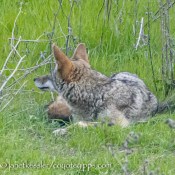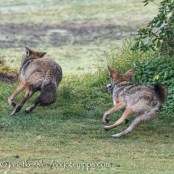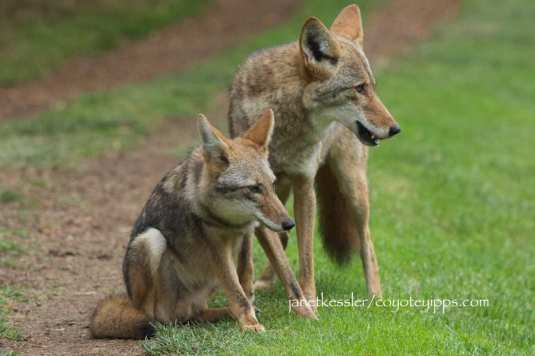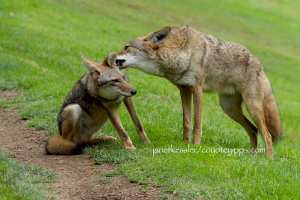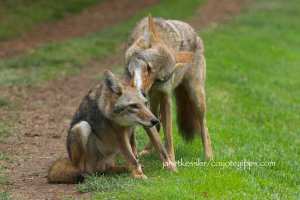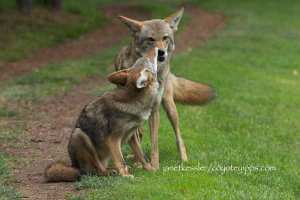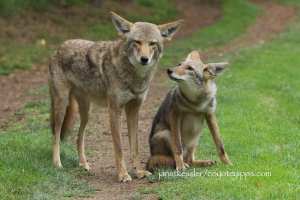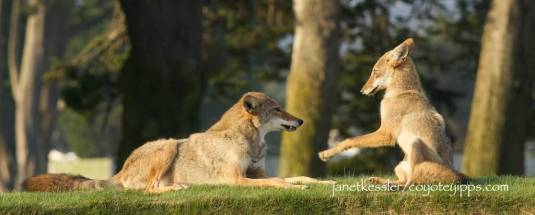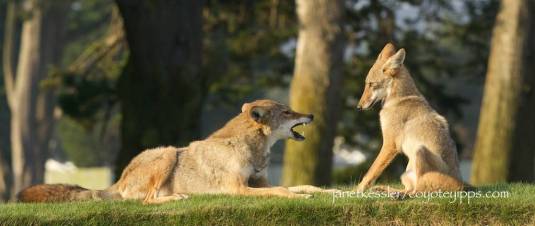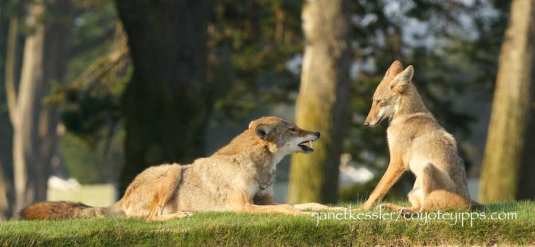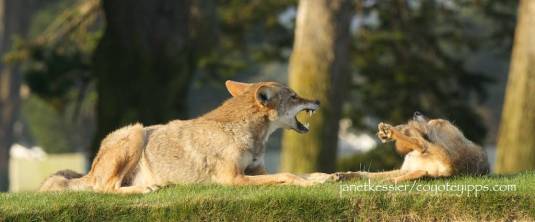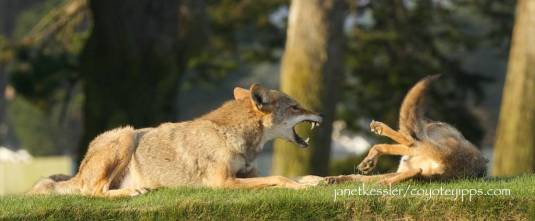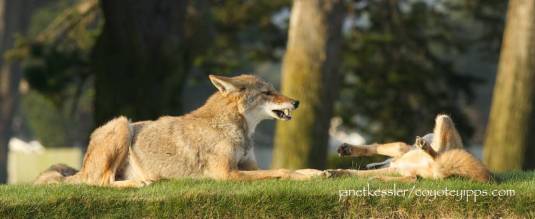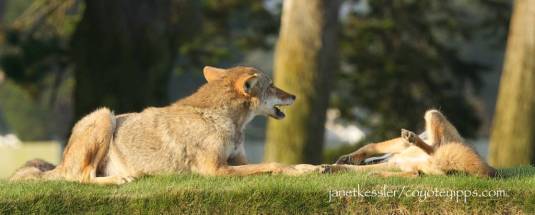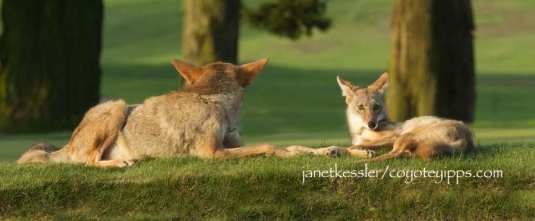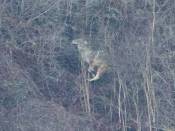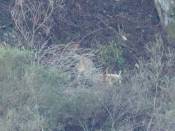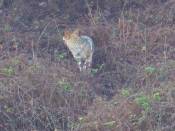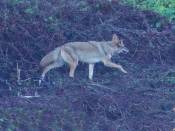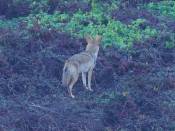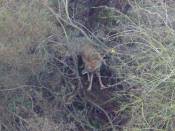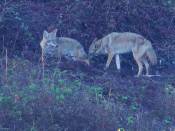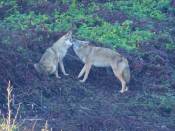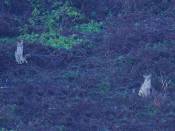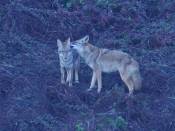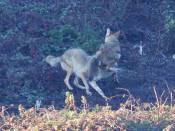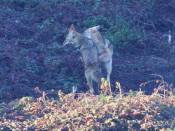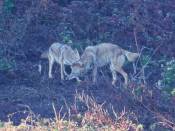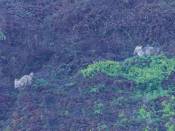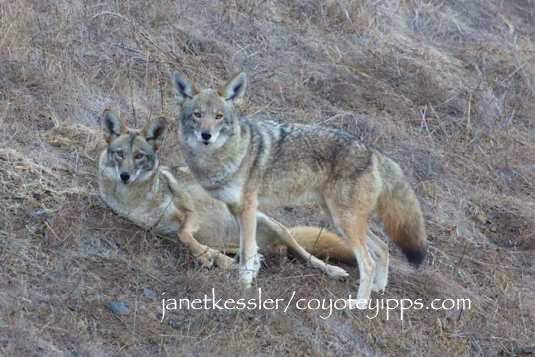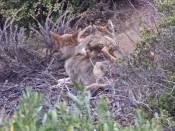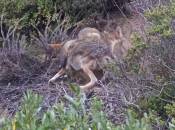I hope this posting clarifies rather than confuses or convolutes what goes into dispersal. I think I’ve covered enough examples to enlighted, but not too many so as to confuse! I’ve included plenty of links to YouTube videos and previous postings of mine.
Dispersal is not a simple cut-and-dry process that occurs on a set schedule: it occurs at any time of the year and has a variety of causes pushing and pulling it. I’m sure we all can appreciate that it’s always safer to have a territory and remain on one than not: coyotes are familiar with existing dangers and food sources on their own territories whereas they are not outside of that area. From what I’ve seen, the majority of coyote deaths occur during dispersal, away from their territories, most of those in urban areas by cars, though of course younger and inexperienced coyotes aren’t much safer from cars within their own territories. So that’s an important factor involved in dispersal.
Another factor is the changing quality of play over time. Initially, coyote littermates learn by playing innocently with each other — it’s great to have a bunch of companions! They learn invaluable and nuanced social skills (how to get along and how not to!), communication skills, hierarchy assessment, etc. They learn their limits, and they learn the limits of their siblings: they learn when they’ve gone too far. Most play is on the level of horsing around, teasing, provoking, and competitive. It includes chase-me, keep-away, wrestling, tug-of-war, pouncing, stealing, grabbing, etc. Very little of it is cooperative, except that they are engaging with each other and learning the rules together and through each other, learning to apologize in order to keep a game going, etc. Even so, I’ve seen plenty of cuddling and grooming, and the growth of very special sibling bonds as seen in the two photos below. Above is a video of siblings playing, showing how rough and tumble it is.



Roughhousing can escalate: if they want to play with a sibling who doesn’t like the roughness, they learn to tone it down. Those individuals who withdraw from rougher play either can’t keep up, don’t like it, or are innately less socially interactive than their siblings: innate personalities which they are born with are always a part of the equation. They may prefer sitting to the side and watching, or going off on their own. This little girl to the right remained aloof of rough play, but the little girl in the video above resigned herself to being batted around rather than be excluded.



These photos above are of brother siblings whose playing has turned more serious: more of, “Take that, and I mean it.” One youngster still wanted to get along, but the other wanted brother gone.
Unwelcome teasing, bullying, one-upmanship, all of which are involved in establishing a hierarchy or challenging it, can segue into visceral dislike and antagonism, and ultimately avoidance of a sibling. OR their internal clock begins telling them to exclude others of the same sex, especially the males. For females, growing antagonism appears to be more often on a mother-daughter level as far as I’ve seen. After all, coyotes live pretty much in long-lasting monogamous pairs, so this is ultimately what they are programmed for: reproductive rivals must be excluded. They are *nuclear family* animals as opposed to *pack* animals.
This video above shows sibling rivalry between an older sister and a younger brother: I haven’t seen as much male/female sibling rivalry, but here are two examples. 1) The young male in the video has taken on their mother’s attitude towards his sister. Mother had been regularly attacking the sister in an attempt to get her to disperse. Sister sulked but didn’t leave. The mother’s repeated negative treatment of Sister seems to have given license to this brother to ceaselessly taunt her and egg her on as in this video. Note the purposeful teasing and body slams for no other reason than to annoy her and cause a reaction. And here is more brother/sister “Friction Between Almost Two-Year-Old Siblings”. Sometimes the differences are worked out, keeping the family intact a little longer, but soon there are departures.
In the photos below, you see on the right, bowing submission to the hackles-up guy who could no longer stand his brother’s presence: the kowtowing brother was soon driven out forcefully at 1.5 years of age. He desperately wanted to stay, hanging on as long as he could — he and his mother shared a lot of affectionate interactions and grooming — but the onslaught of his domineering brother become a daily affair. Biting resulting in visible skin wounds and squeals of pain preceded his departure as seen in the photo to the left.


Most of the time, according to what I’ve seen, parents allow youngsters to work out their own interpersonal differences without interfering. But this has not always been the case as when a parent develops a special attachment to one of the youngsters, in which case the parent may discipline the aggressor or soothe the youngster they want to stick around: the aggressive sibling begins to think twice about bullying if the parent is around.
In one very convoluted and complicated case, Mom, repeatedly groomed her two-year old son, Scowl, obviously inviting him to stay on the territory and be her mate. Her long-term mate (the pair was together 9 years) had died of old age the year before, and a new alpha male intruder had come into the picture and even fathered her last litter. But no one in the family liked him as could be seen by their behavior towards him, and Mom kept paying particular attention to Scowl, to the exclusion of that fellow. Scowl was the apple of her eye, and within the new pups’ 4-month birthday, that outsider male left. Now Scowl, at three years of age, rules the roost with his mom, which is what they all wanted ever since Mom’s previous mate passed away. And they are all now apparently very happy!




Antagonism and negativity aren’t always the instigators of dispersals. At some point, some yearlings just pick up and go — negativity or not. However, others stay on, even with growing negativity and battling because there’s usually something else attracting them to the area. Such was the case with Gumnut several years ago. His dad kept attacking him, but Gumnut always submitted and slunk away, skirting the dispersal issue. He and his sister were inseparable best buddies. Mom had died, so Dad actually had his eye on his daughter as his future mate, and at two years of age, through domination, he indeed took her over. (Yes, there’s lots of inbreeding in coyote families). Gumnut stayed around until the single pup who was born to Dad and Sis turned 7 months old, braving it through repeated attacks from his father, and then, suddenly one day, at 2 1/2 years of age, after hearing a particularly painful long-lasting squeal from him which I gathered indicated he was bitten, we never saw him again. That he put up with the severe put-downs and blows handed out by his Dad for so long was amazing to me. Gumnut had been undeterred because something more important was drawing him in: his best buddy and sister. I’m sure they would have become a mated pair had Dad not intervened.

Mothers may start harsh discipline of daughters early on: I’ve speculated that it’s because of reproductive rivalry. I haven’t seen it often, but I have two video examples of it: 1) Maeve beating up her seven-month old daughter: this dominant and aggressive treatment might also ensure rank is established early on, making dispersal that much easier. Might this daughter have been exhibiting a dominance streak, or even cozying up to her dad?? Again, this is speculation. 2) Here are two brothers vying for sister’s affection: notice the second brother repeatedly inserts himself between his brother and sister. Three is a crowd, so one will eventually leave. Interestingly, in this particular case, the female ditched both related males and paired up with an outsider. 3) And here is another instance of Mom, Maya, attacking her yearling daughter Sissy. On the flip side, I’ve also seen a daughter who stayed and ended up den-sharing with her mother. As I say, there is nothing cut-and-dry about dispersal.

Here is more on Beating and rank issues leading to dispersal. And here is a mother roughly disciplining her son as the father watches: rank issues are kept alive right from the start which makes dispersal issues that much easier.

Another several examples of dispersal behavior, and behaviors leading up to dispersals can be found in THIS posting. Here, I describe three dispersals from the same family, beginning with a very friendly send-off by a Dad, Ivan, to his son, Hawkeye, who was 14 months old. I got the sad impression that both father and son were very aware of the mites and bugs infesting the son’s coat, meaning his immune system was down. Possibly they both knew son wouldn’t make it even though he would try. Again, this is simply my interpretation. After this sendoff, I never saw Son again. Another son of Ivan’s began distancing himself from the rest of the family by keeping to the fringes of the territory at a great distance from the rest of the family, and then one day he simply left — he was ready to go at 1.5 years of age. The last instance in the above posting is a father’s, Ivan’s, return to check on his daughter, Sissy, on a territory he and his mate had abandoned, possibly due to its being the end of their reproductive years, leaving daughter on that territory. Had they ceded the territory to her? He seems to be checking on her, and even saying goodby. He never came back after this visit. Ivan was the most benevolent of fathers — I never saw him attack or discipline any of his children (though he did so to intruders), rather he always parted on good terms: he was the epitome of a leader, whereas you have seen from some of these videos that that is not always the case.

And my final example is of Sparks. He preferred not dealing with a brother who began trying to dominate. He initially left with his sister, the one in the video linked below, but she returned to her birthplace whereas he continued on and found a permanent place to live on the edge of another family’s territory. I have not seen him with another mate, though I’m hoping this situation might come about. His present status, at 3 years of age, is sort of an interloper with a fairly permanent and defined territory (which is a contradiction). Sparks: A Happy Springtime Update. Sparks came from a litter that had formed incredible caring bonds with each other, and here is a video showing his sister’s concern and care for him. In the video, Sparks was the coyote youngster with the injury.




